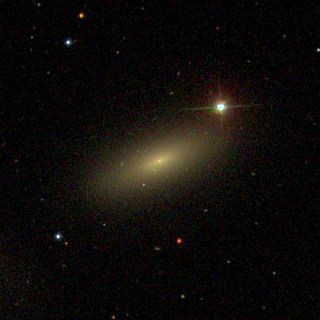
NGC 55, is a Magellanic type barred spiral galaxy located about 6.5 million light-years away in the constellation Sculptor. Along with its neighbor NGC 300, it is one of the closest galaxies to the Local Group, probably lying between the Milky Way and the Sculptor Group. It has an estimated mass of (2.0 ± 0.4) × 1010M☉.

NGC 659 is an open cluster in the Cassiopeia constellation. It was discovered by Caroline Herschel in 1783.

The Crescent Nebula is an emission nebula in the constellation Cygnus, about 5000 light-years away from Earth. It was discovered by William Herschel in 1792. It is formed by the fast stellar wind from the Wolf-Rayet star WR 136 colliding with and energizing the slower moving wind ejected by the star when it became a red giant around 250,000 to 400,000 years ago. The result of the collision is a shell and two shock waves, one moving outward and one moving inward. The inward moving shock wave heats the stellar wind to X-ray-emitting temperatures.

NGC 6027 is a lenticular galaxy discovered by Édouard Stephan in 1882 that is the brightest member of Seyfert's Sextet, a compact group of galaxies.

NGC 4976 is a peculiar elliptical galaxy in the constellation Centaurus. It was detected with a 5" telescope working at 20x magnification by comet hunter Jack Bennett.

NGC 4984 is an intermediate lenticular galaxy exhibiting a double ring structure in the constellation Virgo. It is a member of the NGC 4856 Group of galaxies, which is a member of the Virgo II Groups, a series of galaxies and galaxy clusters strung out from the southern edge of the Virgo Supercluster. In December 2011, supernova 2011iy was discovered in it.

NGC 6826 is a planetary nebula located in the constellation Cygnus. It is commonly referred to as the "blinking planetary", although many other nebulae exhibit such "blinking". When viewed through a small telescope, the brightness of the central star overwhelms the eye when viewed directly, obscuring the surrounding nebula. However, it can be viewed well using averted vision, which causes it to "blink" in and out of view as the observer's eye wanders.

NGC 6755 is an open cluster of stars in the equatorial constellation of Aquila, positioned about 3° to the east of the star Delta Aquilae. It was discovered by the Anglo-German astronomer William Herschel on July 30, 1785. Located at a distance of 8,060 light years from the Sun, it lies 30′ to the northeast of NGC 6755, with the pair forming a visual double cluster. However, they probably do not form a binary cluster system since they have different ages and are too distant from each other.

NGC 250 is a lenticular galaxy in the constellation Pisces.

NGC 88 is a barred spiral galaxy exhibiting an inner ring structure located about 160 million light years from the Earth in the Phoenix constellation. NGC 88 is interacting with the galaxies NGC 92, NGC 87 and NGC 89. It is part of a family of galaxies called Robert's Quartet discovered by astronomer John Herschel in the 1830s.

NGC 4780 is an intermediate spiral galaxy within the constellation Virgo. It is located about 166 million light-years away from the Sun. It was discovered in 1880 by the astronomer Wilhelm Tempel.

NGC 156 is a double star located in the Cetus constellation. It was discovered on 1882 by Ernst Wilhelm Leberecht Tempel.

NGC 4436 is a lenticular or dwarf elliptical galaxy located about 60 million light-years away in the constellation of Virgo. NGC 4436 was discovered by astronomer William Herschel on April 17, 1784. The galaxy is a member of the Virgo Cluster.

NGC 2300 is a lenticular galaxy in the constellation Cepheus. It was discovered in 1871 by French astronomer Alphonse Borrelly using an 18 cm telescope.

NGC 900 is a lenticular galaxy located in the constellation Aries about 430 million light-years from the Milky Way. It was discovered by the German astronomer Albert Marth in 1864.

NGC 980 is a lenticular galaxy located in the constellation Andromeda about 256 million light years from the Milky Way. It was discovered by the German - British astronomer William Herschel in 1786.

NGC 904 is an elliptical galaxy in the constellation Aries. It is estimated to be 244 million light years from the Milky Way and has a diameter of approximately 85,000 ly. NGC 904 was discovered on 13 December 1884 by the astronomer Edouard Stephan.

NGC 906 is a barred spiral galaxy in the constellation Andromeda in the northern sky. It is estimated to be 215 million light years from the Milky Way and has a diameter of approximately 110,000 ly. NGC 906 was discovered on October 30, 1878 by astronomer Édouard Stephan.

NGC 531 is a barred spiral galaxy in the constellation Andromeda with a visual magnitude of 10.51. It is a distance of 65.7 Mpc from the Sun. It is a member of the Hickson Compact Group HCG 10, and is interacting with the other members of the group.

NGC 862 is an elliptical galaxy located in the constellation of Phoenix about 241 million light years from the Milky Way. It was discovered by the British astronomer John Herschel in 1834.




















